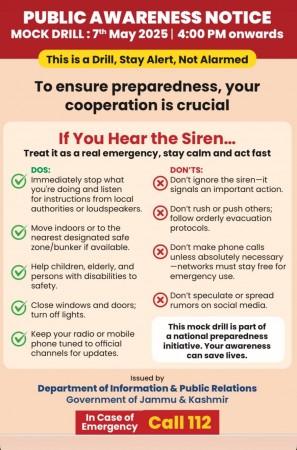
As part of preparedness and public awareness measures, authorities will conduct a nationwide air raid mock drill tomorrow across several cities in India. Citizens may hear loud sirens or alarm sounds, which are part of this planned exercise. The civil defence mock drills in Karnataka will begin on May 7 for a week in three districts.
Following a high-level meeting with the Union Ministry of Home Affairs, Karnataka launched a state-wide civil defence preparedness initiative, codenamed Operation Abhyaas, beginning May 7 at 4 PM. The first drill is being held at the premises of the Director General, Civil Defence, in Bengaluru.
DGP Prashanth Kumar Thakur, who heads the Civil Defence, Home Guards, and SDRF, said the drills aim to identify and fix gaps in emergency response mechanisms. Bengaluru has 35 air raid sirens—32 of which are operational—and drills will include hospital mobilisation, rescue, and relief protocols.
While there is no cause for panic, it's important to understand what these sirens mean and how civilians are expected to respond, especially in the event of an actual emergency in the future.
Here's a step-by-step guide on what to do if you hear an air raid siren in India, including instructions for tomorrow's mock drill.
What does an Air Raid Siren mean?
An air raid siren is an emergency warning signal indicating a potential threat — usually from the air, such as missiles or aircraft attacks. While India is not in a state of war, these drills are essential to ensure public readiness and response protocols are in place.
During tomorrow's mock drill, sirens may sound like a wailing tone that rises and falls, usually lasting 1 to 2 minutes.
What should you do when you hear the siren?
1. Don't Panic
Recognize that tomorrow's drill is a planned exercise.
Stay calm and follow instructions from local authorities or building security.
2. Immediately seek shelter
Move indoors immediately. If you're already inside, stay there.
Avoid standing near windows, balconies, or open areas.
3. Turn off gas & electricity (If at home)
Switch off LPG, gas burners, and unnecessary electrical appliances.
This is a precaution to avoid accidental fires or damage in case of power fluctuations.
4. Stay low and away from glass
Move to the most interior room or a designated shelter area in your building.
Stay away from windows, mirrors, and glass doors.
5. If outdoors, lie flat or take cover
If you're in a public place with no immediate shelter, lie flat in a low area or behind a solid structure.
Use backpacks or jackets to protect your head.
6. Use emergency apps or radios
Tune into government advisories via radio, TV, or official apps like NDMA India, MyGov, or your local disaster management authority.
Avoid social media rumors — only follow verified updates.
7. Do not use roads unless instructed
Stay off roads unless evacuation is announced.
Emergency services will have the right of way; unnecessary movement may block their operations.
8. Follow all official instructions
Wait for an "All Clear" siren, which is usually a long, single-tone sound.
Until then, remain sheltered.
Purpose of the mock drill
- How to respond without panic.
- How to guide children, elderly, and others to safety.
- How to stay informed through official channels.
The aim is to create a culture of civilian preparedness— a crucial aspect of national security and disaster response planning.

Mock drill in Bengaluru (Cat II)
In Bengaluru, the drill covers high-security areas such as ISRO, DRDO, and the Yelahanka Air Force Base, given the city's dense population and critical tech infrastructure. Karwar is selected for its Kaiga nuclear power plant and INS Kadamba naval base, while Raichur is included due to the Raichur Thermal Power Station, a major electricity source.
The mock drill involves coordinated efforts from the Civil Defence, Home Guards, and SDRF teams. Civilians, especially students, participate in air raid siren responses, blackouts, and evacuation exercises. The drills conclude by 4 PM.
According to sources, the mock drill will be held at the following locations in Bengaluru: Indian Institute, CQL, ESI Hospital, NAL, Bangalore Dairy, Canara Bank, SRS Peenya, V.V. Tower Fire Station, Jnanabharathi Fire Station, Thanisandra Fire Station, Banaswadi Fire Station, Yeshwanthpur Fire Station, Banashankari Fire Station, Rajajinagar Fire Station, Chamarajpet Fire Station, Commercial Street Police Station, Halasuru Gate Police Station, Halasuru Police Station, Upparpet Police Station, Rajarajeshwari Nagar Police Station, Kamakshipalya Police Station, K.R. Market Police Station, Vyalikaval Police Station, Halasuru Home Guards Headquarters, Peenya Fire Station, Bengaluru Rural Home Guards Office, Bagalur Fire Station, Anjanapura Fire Station, ITPL Fire Station, Sarjapur Fire Station, Electronics City Fire Station, and Dairy Circle Fire Station.
Areas where sirens may be heard
Authorities have advised that the mock drill will be conducted in select metro cities and border regions. The civil defence rehearsal will be held across 244 officially designated Civil Defence districts.
Tomorrow's mock drill comes in the wake of the Pahalgam terror attack on April 22, which claimed the lives of 26 civilians. The attack, which is reportedly backed by Pakistan-based groups, has escalated tensions between the two countries. If you hear the siren tomorrow, remember — it's a drill. But the experience might save lives someday.

















